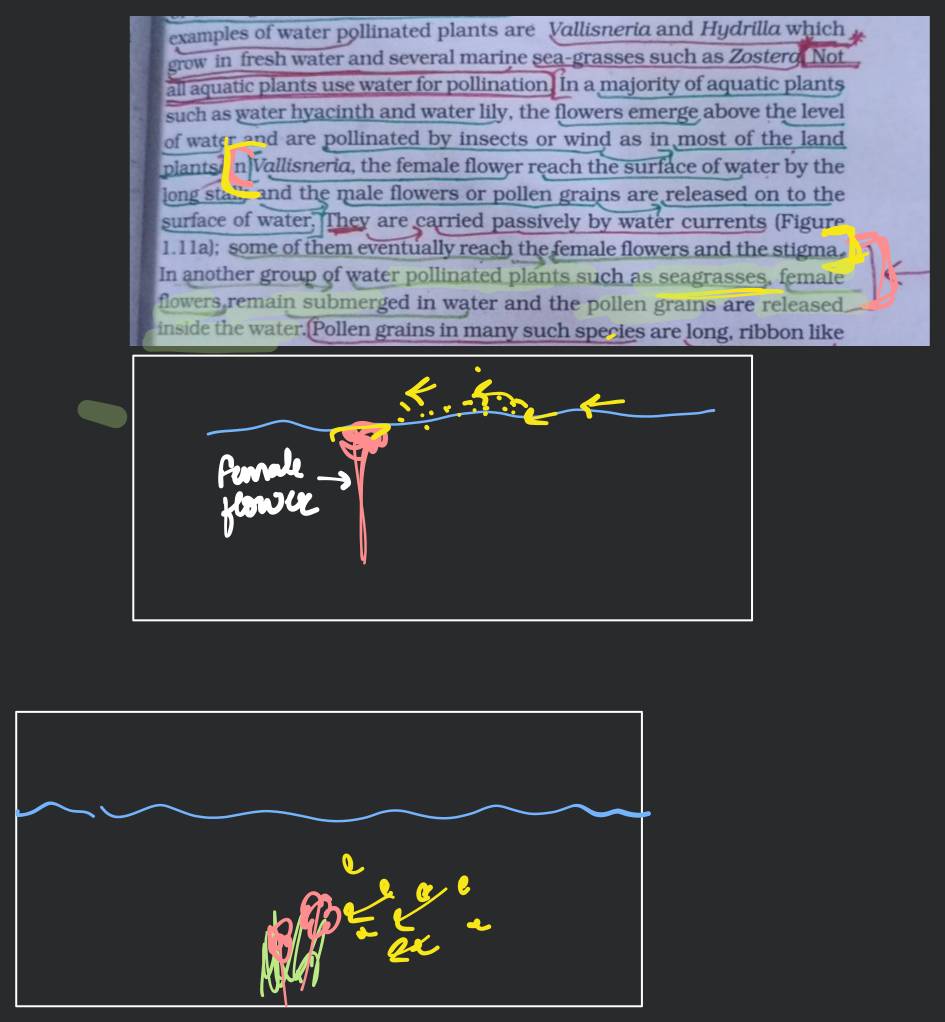Question
Question asked by Filo student

examples of water pollinated plants are Vallisneria and Hydrilla which grow in fresh water and several marine sea-grasses such as Zosterg Not all aquatic plants use water for pollination. In a majority of aquatic plants such as water hyacinth and water lily, the flowers emerge above the level of water and are pollinated by insects or wind as in most of the land plants. In [Vallisneria, the female flower reach the surface of water by the long stalk and the male flowers or pollen grains are released on to the surface of water. They are carried passively by water currents (Figure 1.11a); some of them eventually reach the female flowers and the stigma. In another group of water pollinated plants such as seagrasses, female flowers, remain submerged in water and the pollen grains are released inside the water. Pollen grains in many such species are long, ribbon like
Found 4 tutors discussing this question
Discuss this question LIVE
13 mins ago

One destination to cover all your homework and assignment needs
Learn Practice Revision Succeed

Instant 1:1 help, 24x7
60, 000+ Expert tutors

Textbook solutions
Big idea maths, McGraw-Hill Education etc

Essay review
Get expert feedback on your essay

Schedule classes
High dosage tutoring from Dedicated 3 experts
Practice more questions on Plant Physiology
Question 2
Medium
Views: 6,067
(ii) Name the scientist whose contribution led to development of semi-dwarf wheat varieties in India.
Question 3
Easy
Views: 6,025
(A) Placenta only
(B) Placenta as well as fully developed foetus
(C) Oxytocin released from maternal pituitary.
(D) Fully developed foetus only.
Students who ask this question also asked
Question 1
Views: 5,540
Question 2
Views: 5,555
Question 3
Views: 5,791
Question 4
Views: 5,700


Stuck on the question or explanation?
Connect with our Biology tutors online and get step by step solution of this question.
231 students are taking LIVE classes
| Question Text | examples of water pollinated plants are Vallisneria and Hydrilla which grow in fresh water and several marine sea-grasses such as Zosterg Not all aquatic plants use water for pollination. In a majority of aquatic plants such as water hyacinth and water lily, the flowers emerge above the level of water and are pollinated by insects or wind as in most of the land plants. In [Vallisneria, the female flower reach the surface of water by the long stalk and the male flowers or pollen grains are released on to the surface of water. They are carried passively by water currents (Figure 1.11a); some of them eventually reach the female flowers and the stigma. In another group of water pollinated plants such as seagrasses, female flowers, remain submerged in water and the pollen grains are released inside the water. Pollen grains in many such species are long, ribbon like
|
| Updated On | May 5, 2023 |
| Topic | Plant Physiology |
| Subject | Biology |
| Class | Class 12 |
| Answer Type | Video solution: 1 |
| Upvotes | 113 |
| Avg. Video Duration | 5 min |




